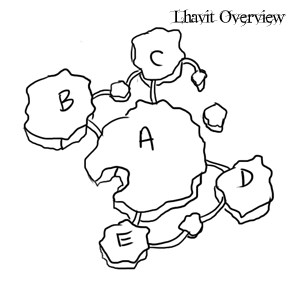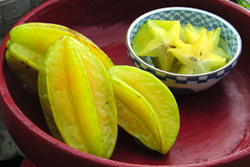Lhavit
From Mizahar Lore
(→Cuisine) |
(→Infrastructure) |
||
| Line 45: | Line 45: | ||
D. '''The Tenten''' is the eastern most peak and home of the Temple of the Sun, the Dawn Tower and the Bharani Library. This peak's residents usually wear vibrant colors of orange, yellow and white to reflect the coming of first lights on their estates. | D. '''The Tenten''' is the eastern most peak and home of the Temple of the Sun, the Dawn Tower and the Bharani Library. This peak's residents usually wear vibrant colors of orange, yellow and white to reflect the coming of first lights on their estates. | ||
| - | E. '''The Sharai''' is the southern most peak and home of the Twuele, the neverending tower. This area is also the most encased in greenery, and where most of the Okomos are kept. There is a spacious pasture man-made for these animals, and a large garden both above and below to grow a variety of fruits and vegetables. | + | E. '''The Sharai''' is the southern most peak and home of the Twuele, the neverending tower. This area is also the most encased in greenery, and where most of the Okomos are kept. There is a spacious pasture man-made for these animals as well as for livestock, and a large garden both above and below to grow a variety of fruits and vegetables. |
== Climate and Geography == | == Climate and Geography == | ||
Revision as of 06:31, 13 October 2010
 | |||||||
| Region | Kalea | ||||||
|---|---|---|---|---|---|---|---|
| Notability | Home of Zintila, crystalline city in the mountains. | ||||||
| Leader | Zintila, Anchorite Hayani | ||||||
| Population | 7,000 | ||||||
| Races |
| ||||||
| Languages | Lhavitian, Vani, Nari, Common | ||||||
| Currency | Kina | ||||||
| Imports | Many goods | ||||||
| Exports | Crystals, Jewelry, Books, Tourism, Maps | ||||||
Lhavit is often referred to as “The Floating City of Stars,” and is located on the far Western Hemisphere of Mizahar. It is a city entirely built of a unique material based on the gnosis of their matron Alvina, Zintila. Grand glittering crystal temples and homes stand as a testament to it’s sturdiness atop enormous peaks, totaled five in all, and wide enough to house miniature “tiers” unto themselves. All of these peaks are connected by slender bridges built from the same material as the structures, and many hidden caves riddled throughout the tiers offer suitable places to grow gardens for their own sustenance. At night, the city glows under the influence of Zintila’s stars, a spectacle to behold, and a marvel that every denizen of Mizahar must view at least once in their lifetime.
Contents |
History
Lhavit had not always been the graceful “floating” city of stars. In the times preceding the Valterrian, the Lhavitians were a tribal folk who lived their lives in worship of Syna, Leth and Zintila. They were a shamanistic people, settling themselves beside the shore in the far reaches of the West, when the mountains were not mountains but small, less formidable structures in the lands of Suvan. They did not take to their cousins, the Vantha, for they preferred the guidance of the stars and the universe about them than the chilling atmosphere of Morwen’s lair. When war struck, and destruction reigned down on Kalea, the tribal people’s homes were destroyed, their hope dwindling when mountains grew all around them, cutting them off from the sea. They turned to Zintila for guidance through the winding structures, and the demigoddess, seeing her followers suffering, answered their pleas. She bestowed upon the most devoted the ability to create structures from the components of stars and meteors, and instructed them to build a civilization high above the ground where they could blur the line between the universe and themselves.
These people did just so, using their ancient companions the Okomo's to guide them where they could not originally tread and the city of Lhavit came to be. Born from high peaks connected by winding, slender bridges and mists surrounding their mountaintops gave the illusion of a “floating” haven. They became the people of the stars, and built their homes to reflect such. They retained some aspects of their ancestral, tribal ways, but honored their Lady by studying dutifully the ways of stars, coordinates and constellations.
In 402 A.V., the first outsiders arrived on the central platform of Lhavit; the Eagle Riders of Wind Reach had discovered the floating city perhaps by chance, but once word of the city exploded amongst travelers, it was not long before there was a steady trickle of curious and brave individuals. Inns were built for the weary, and doors were open to all. Trade became something Lhavit was fond of, for many of its denizens have yet to step foot outside the sanctity of the grand haven. Knowledge was bartered and traded, and tourism of the entire crystalline city became a major source of income.
Infrastructure
Lhavit is a city built on expansive mountain peaks, so it is safe to assume that because of a lack of width, the denizens build up, creating tiers on each peak traversable by well carved stairs. Upon entering the city, one could notice there are many many towers riddling the surrounding vicinity, but these are not ordinary towers. They glow with their own light, shift in hues and melt with the colors of sky during peak hours of a day, dawn, dusk, twilight and eventually night. The city itself is divided into five peaks, with a myriad of smaller ones used as a pit stop for bridges to connect to each respective larger peak. They are named as follows:
A. The Zintia is the center peak that resembles more of a bluff than a peak. It is the widest, and houses the Surya Plaza as well as Zintila's abode. This is the center meeting area for most citizens and visitors, as it is spacious and accommodates to all with their shops and inns. Upon entering Lhavit via the winding path, this is where a visitor ends up first.
B. The Shinyama is the peak directly to the west of the Zintia. It houses the Shinyama Pavillion, home and training center of the Shinya. This peak is also home to the Temple of the Moon and the Dusk Tower. The people here wear any shade of blue, purple or black to reflect the moon and the sky.
C. The Sartu is the northern most peak and the tallest of the five. It is home to Iraltu's Observatory and the Twilight Tower. The Temple of Time is also located here, nestled on the second tier of the peak. A mixture of both yellows orange and shades of blue are common for the people living here. They get the best of both worlds.
D. The Tenten is the eastern most peak and home of the Temple of the Sun, the Dawn Tower and the Bharani Library. This peak's residents usually wear vibrant colors of orange, yellow and white to reflect the coming of first lights on their estates.
E. The Sharai is the southern most peak and home of the Twuele, the neverending tower. This area is also the most encased in greenery, and where most of the Okomos are kept. There is a spacious pasture man-made for these animals as well as for livestock, and a large garden both above and below to grow a variety of fruits and vegetables.
Climate and Geography
Being settled on high peaks, Lhavit is susceptible to bouts of moderately short, hot summers, and freezing cold winters. This seems to affect the plant life thriving on the peaks and in the cities very little, for there is an abundance of greenery on them due to special care. The sturdy nature of their unique buildings makes the worry of storms nearly nullified.
Around the city are many many more peaks, some used as watch points and others a shield against the occasionally harsh winds from the sea that lay not far off. A river crosses at the foot of the center peak of Lhavit, fed from a waterfall straight to the west. Mist is abundant here, giving the illusion that the city sits on a cloud.
Culture and People
Lhavit’s denizens total 7,000 in all, composed of artists, scholars and magicians. They do not fear the unknown here, for they are exposed to it on a daily basis, the magnificent transcendence of the skies reflects in the buildings they have created. They are a generous people, willing to part with their information in exchange for other, interesting things from across the world. They are airy, whimsical and enjoy having their times of fun as much as the next. To foreigners, they are hospitable, even amidst the harsh peaks of their environment, but they are not without dealing judgment upon those who threaten the sanctity of their city.
Ranking
- Star Lady - The head of Lhavit is the Alvina, Zintila. She is deemed the Star Lady, and holds greater power here than any individual. Her word is law, and it is to be followed without question, or risk reprimand.
- Anchorite - Below the Star Lady is the Anchorite Hayani, the Voice of the Stars. When Zintila is absent, she is left to care for her city, and does so with great devotion and care.
- Shinya - Are below the Anchorite. They are the protectors of the city, exceptional projectionists and martial artists, they are to be respected and honored for their sacrifice to provide a defense against those who would hurt them.
- Sesul - Priests and scholars are respected nearly as much as the Shinya, for they are the seekers of knowledge long since lost to them, and provide information to the people. They primarily answer to Anchorite Hayani and Zintila.
- Aisha - Merchants, artists and caretakers are a vital part of Lhavit, but do not require as much attention or honor as a Sesul or a Shinya. There are benefits to being them, but the benefits do not outweigh those above them.
- Shimobe - The servants of Lhavit are the lowest in rank, and do not usually gain much notice in society. They are able to be treated unfairly without any risk of reprimand from the guards.
Holidays
Lhavitians are religious in body and mind but in their hearts they enjoy festivities as much as any Mizaharian. Because of their famed, enormous calendar, it is no mystery that they would celebrate the coming of the Winter and Summer Solstices. They know when eclipses arrive, and celebrate the time when Leth and Syna unite, as well as when an ancient comet crosses the skies overhead. Celebrations for them entail wearing elaborate masks that reflect a part of the starry sky overhead and flowing white dresses. Artificial light, such as fires are rarely, if ever used during festivities, for Lhavitians enjoy mimicking the sea of stars during such special events with their white or bright yellow garbs amidst an inky black backdrop.
Cuisine
Lhavitians eat light quantities of meat, fruit and vegetables. They grow their foods primarily in the Turov Gardens, east of the Okomo Villa and north of the man-made pasture for the livestock they breed and domesticate for the sole purpose of food. In the northeast and northwest points of the Zintia peak are two large pulleys used to haul up meat and rice hunters and farmers bring home from a day in the wilds with the help of their Okomo mounts. This is not to be mistaken for the entrance to the city, for the only entrance is the Amaranthine Gate, and these "elevators" are manned by a team of men only during certain hours of the day.
Types of meat Lhavitians breed include but are not limited to, sheep, smaller goats and slow lumbering beasts found in the wilds. Vegetables and fruits include a wide variety, with the most famous being the Yatani, or the Star Fruit, found only around the city of Lhavit. Rice is a staple food here and is grown on the ground level of the Misty Peaks, where agriculture has allowed the people to create an ample water source from the Amaranthine River to supply the rice fields with water.
Lhavitians typically have two main meals a day, with a light snack in between each meal sometimes referred to as "brunch". Most of their food tends to be spicy, as they greatly enjoy the flavor, much to the annoyance of some foreigners.
Factions
The Shinya
The Shinya are the protectors and guardians of Lhavit. They are master projectionists, and utilize their martial arts to aid their projection in creative ways. They are devoted to the safety of Zintila, Lhavit and her citizens and are known to be quite brutal when they are provoked. The Shinya almost always shave their heads clean, except for the women, who always keep it in a tight but elaborate bun, and wear robes of black with a strip of light blue cloth over the top, and one tight at the waist to hold. During combat, they wear something similar, but instead of a robe, it is a loose tunic with leather armor to protect them when it is needed. But not always are they called to battle. They patrol the city, or they're stationed at towers or balconies to overlook the five peaks. The Shinya are respected and chosen for their devotion to Zintila, the Anchorite and their people, and many if not all of them are kind to strangers, but always guarded. The Shinyama Pavilion is where they train and accept those willing to serve Lhavit in the name of Zintila.
Locations of Interest
TBA



